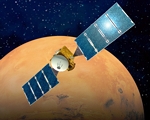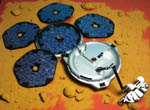
19 May 2003 - UCL scientists look for water on Mars with Mars Express and Beagle 2
The launch date has now been set for Europe's first mission to Mars. On the 2 June 2003 at 18:45 BST, the Mars Express orbiter, together with the Beagle 2 lander, will soar above the steppes of Kazakhstan on a Soyuz-Fregat rocket. The launch window lasts until 21 June and the arrival at Mars is just before Christmas 2003. UCL-MSSL scientists are eagerly awaiting the launch for three reasons: they are involved in instruments on both the lander and orbiter - and they wish to study water in the Martian environment.
Water is important on Mars as it is a key ingredient for life. Scientists think that 3.8 billion years ago Mars had flowing water on the surface, a thick atmosphere and a protecting magnetic shield like the Earth's. Now, all that is gone and Mars is dry and barren, has a thin carbon dioxide rich atmosphere, and has no large scale magnetic field. However recent discoveries by other spacecraft have shown that there may still be water, probably in the form of permafrost, within a metre of the surface in the Martian polar regions. There may even be water covered by snow packs on the surface. All this points to better conditions for life on Mars 3.8 billion years ago - and a very slim chance now too.
Mars Express OrbiterDr Andrew Coates, UCL-MSSL's lead scientist for Beagle 2 and Mars Express says 'We are in a pivotal position to look for water on Mars at UCL, as we are one of only very few scientific groups are involved in lander and orbiter. With our stereo camera system on the surface we will look for water in the atmosphere, and our involvement with an experiment on the orbiter will allow us to measure how quickly water escapes from the atmosphere, scavenged away by the solar wind. Combined with other instruments on the orbiter which can look for water up to 5km under the surface, Europe is going to make vital new discoveries about water on Mars with this mission. We will have a key role in this'.
Beagle 2 landerUCL-MSSL lead the international stereo camera team for the Beagle 2 camera. These are the 'eyes' of Beagle 2 - and as well as making three dimensional maps of the landing site, vital for Beagle's other instruments, the cameras will study the Martian geology, measure water and dust in the atmosphere and even do some astronomy. Images soon after landing will help scientists steer by the stars as they locate the lander precisely on the surface.
Building for the surface of Mars has been a challenge. Stereo camera system project manager Dr Andrew Griffiths says 'Our cameras and filter wheels will have to survive huge temperature swings, from -100 to 0 degrees between night and day on the surface. We also have to cope with dust and have installed, and tested, windscreen wipers for the cameras to reduce this. Everything is working fine and we can't wait for Beagle 2 to land on the surface'.
UCL-MSSL is also co-investigator on the ASPERA experiment on the orbiter. This will measure how much material escapes from the Martian atmosphere at present. This can then be extrapolated back 3.8 billion years to understand whether the solar wind scavenging is sufficient to explain Mars' atmospheric loss since then.
• Contacts:
Dr Andrew Coates - Beagle 2 Stereo Camera System lead investigator, and Mars Express ASPERA co-investigator
Phone: 01483 204145
Email: ajc@mssl.ucl.ac.ukDr Andrew Griffiths - Beagle 2 Stereo Camera System project manager
Phone 01483 204288
Email: adg@mssl.ucl.ac.uk• Images:
• Websites:
http://www.mssl.ucl.ac.uk/www_plasma/homepage.html - links to Mars Express and Beagle 2 at MSSL-UCL
www.beagle2.com - more information about Beagle 2www.sci.esa.int/home/marsexpress/index.cfm - ESA Mars Express page

